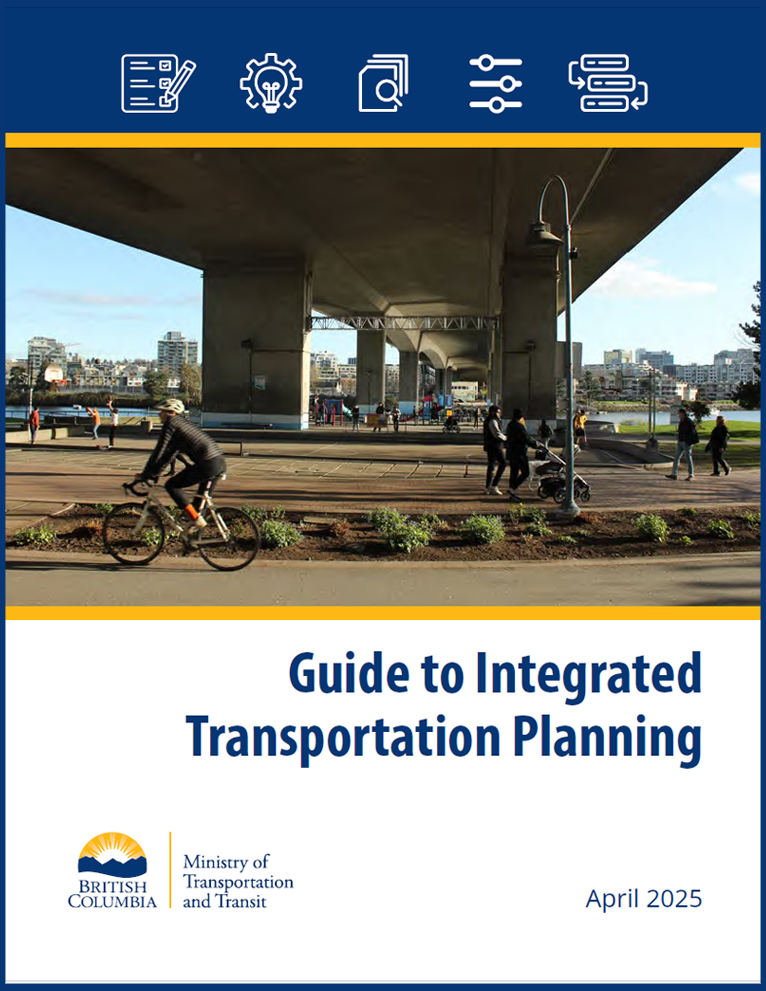Guide to Integrated Transportation Planning
The Guide to Integrated Transportation Planning (ITP Guide) helps advance integrated transportation planning in British Columbia and implement PlanningTogetherBC.
This guide provides a step-by-step approach for aligning provincial and local priorities, optimizing transit and active transportation networks. It is designed to be adaptable, ensuring that rural, suburban and urban areas can benefit from proactive, integrated planning solutions.
The guide offers integrated transportation planning best practices that ensure:
- The benefits of investments are shared for multiple purposes by a wider cross-section of society
- Communities are more connected, improving life, safety and affordability
- People are seamlessly connected to jobs, and goods to markets
- Vehicle travel is reduced system-wide with better transit and active transportation options
- Communities are healthier, more resilient and can better adapt to climate challenges
Download individual guide sections.
Section 1 | About the Guide
1.0 About the Guide (PDF, 803KB)
1.1 Intended Audience
1.2 Application of the Guide
1.3 Relationship with Other Initiatives
Section 2 | What is Integrated Transportation Planning?
2.0 What is Integrated Transportation Planning? (PDF, 904KB)
2.1 Historical
2.2 Evolving Planning Landscape in B.C.
2.3 Why Integrated Planning Is Needed
Section 3 | An Integrated Transportation Planning Framework
3.0 An Integrated Transportation Planning Framework (PDF, 904KB)
3.1 Strategic Goals, Objectives
3.1 Strategic Lenses
Section 4 | Integrated Transportation Planning Process
4.0 Integrated Transportation Planning Process (PDF, 2.4MB)
4.1 MOTT’s Planning Process
4.2 Key Considerations for the Integrated Transportation Planning Process
4.3 Integrated Transportation Planning Assessment Tool
Section 5 | Strategic Transportation Planning Process
5.0 Strategic Transportation Planning Process (PDF, 3.9MB)
PHASE 1 Take Stock of Existing and Future Conditions
Case Study: Moray Area Planning Study (MAPS)
Case Study: South Island Transportation Strategy (SITS)
PHASE 2 Develop Vision, Goals, and Objectives
Case Study: Central Okanagan Integrated Transportation Strategy (CO-ITS)
PHASE 3 Take Stock of Existing and Future Conditions
Case Study: The Central Okanagan Integrated Transportation Strategy (CO-ITS) .
PHASE 4 Refine and Evaluate Options
PHASE 5 Prioritize Recommendations and Finalize Strategy
Case Study: South Island Transportation Strategy (SITS)
Section 6 | Project Development Planning Process
6.0 Project Development Planning Process (PDF, 2.5MB)
PHASE 6 Define the Scope, and Confirm Existing and Future Conditions
Case Study: Highway 101 Alternate Route Planning Study
Case Study: Highway 97 Quesnel Transportation Plan
PHASE 7 Confirm Alignment with Strategic Transportation Plan and Develop Goals & Objectives
PHASE 8 Develop and Screen Opportunities & Options
PHASE 9 Refine & Evaluate Options
Case Study: Highway 97 Quesnel Transportation Plan
Case Study: Highway 97 – Peachland Transportation Study
PHASE 10 Prioritize Recommendations & Finalize Plan
Integrated transportation planning approach
This guide is organized around an integrated transportation planning and development process that aligns with established provincial planning practices and supports the advancement of core priorities.
The provincial transportation planning process includes a hierarchy of plans and strategies across six levels.
This guide focuses on Strategic Transportation Planning and Project Development Planning to help inform policies, programs, and infrastructure decisions at the regional, corridor, and community levels.
- Guide to Integrated Transportation Planning (PDF, 12.1MB)
- Ministry of Transportation and Transit’s Planning Process (PDF, 74KB)
The Integrated Transportation Planning Assessment Tool
To support better decision-making, the Ministry of Transportation and Transit has also developed the Integrated Transportation Planning (ITP) Assessment Tool. The ITP Assessment Tool helps ensure that transportation planning is proactive, well-integrated, and strategically aligned with long-term growth. The tool helps facilitate opportunities that:
- Strengthen regional connectivity and economic growth
- Expand travel choices and optimize existing infrastructure
- Build resilient transportation systems that withstand external challenges
- Support future land use needs while staying cost-effective
- Integrated Transportation Planning Assessment Tool (XLSM, 463KB)
Intended audience
The guide is developed to be a resource for both internal and external planners, engineers, consultants, managers, and technical staff. It can be referenced, in whole or in part, strengthening collaboration and coordination across different levels of government, Indigenous communities, and partners.
Application of the guide
The guide is meant to inform and support the scope, objectives, processes, and outcomes of transportation planning. Given the vast range of community and geographic contexts, types of planning processes, and project specific needs, the guide should be used in a manner that will not prevent professional judgement. It is intended to enhance, and not replace, standards and regulations.
Resources and links
- Guide to Integrated Transportation Planning (PDF, 12.1MB)
- Integrated Transportation Planning Assessment Tool (XLSM, 463KB)
- Ministry of Transportation and Transit’s Planning Process Infographic (PDF, 74KB)
- Strategic Transportation Planning Process Infographic Framework (PDF, 86KB)
- Project Development Planning Process Infographic (PDF, 90KB)
- PlanningTogetherBC
Contact information
For more information about integrated transportation planning contact:
Subscribe
Enter your email address to subscribe to updates of this page.

